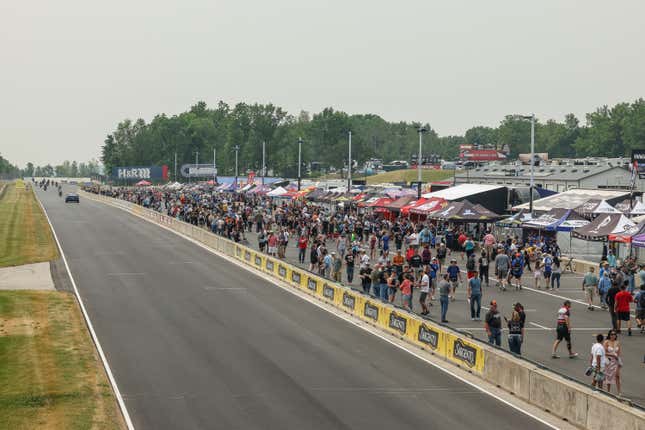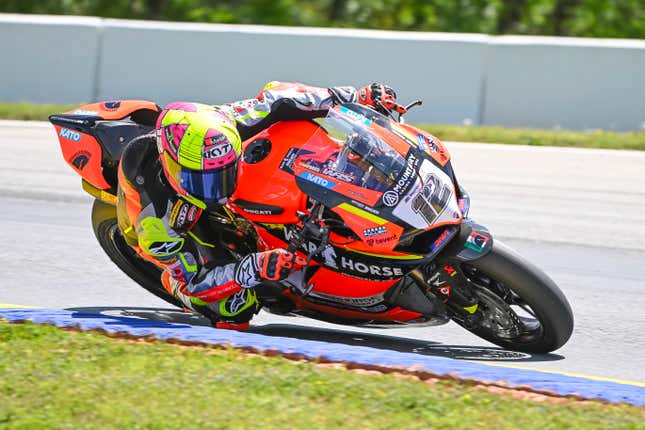Pro Motorcycle Racing's Newest Destination Is MotoAmerica

There was once a time — an era — when Americans ruled MotoGP (or the precursor to it). Those riders included names like Kenny Roberts, Wayne Rainey, Freddie Spencer, and Nicky Hayden — the latter one of the last Americans to take home a world title, way back in 2006. The absence of Americans in the world’s upper echelon of motorcycle racing wasn’t for a lack of talent, by any means, but the U.S. was lacking what most other countries had: a solid series or “ladder” to funnel young riders through to make them competitive enough for the European scene. To change that, in 2014, Rainey, along with Grand Prix World Champion Chuck Aksland, Terry Karges and Richard Varner, created MotoAmerica. But something interesting happened; it wasn’t just the start of a feeder series. In fact, MotoAmerica is becoming a destination for competitive riders of all ages, from around the world.
When Rainey and his partners started MotoAmerica and were also handed control of the AMA Superbike series, it was a shadow of what you’ll now find at the track. Rainey recalled that first year during our interview, noting the differences of a race in 2023, compared to nine years ago.
“I think our first race we had like 65 riders total,” he said. “It’s funny, when I was driving in a racetrack this morning, I remembered, the lines getting into the racetrack that first year were non-existent. …the interest in U.S. racing had fallen so much.”
Back then, the only manufacturers still around were Yamaha, Suzuki, and Kawasaki. But what they could provide for riders was limiting, maybe 12-15 seats. It wasn’t enough to keep riders interested or around, or bring young riders into the mix. They needed more manufacturers. They needed younger riders.
Thus came the Junior and Twins Cup classes: Junior for riders aged 14-28 who ride 4-stroke bikes putting out 50 hp (think Kawasaki Ninja 400, Yamaha’s YZF-R3, KTM RC 390/390R), Twins for riders 15-55 years of age who will ride 100 hp over 600cc-800cc 4-stroke, 2-cylinder bikes. Mini Cup, which would come much later, but would provide a (sometimes adorable) platform for aspiring riders as young as the age of 5 to 16. MotoAmerica was building the support ladder to send racers to compete in championships around the world.
But maybe the ladder is too good, too competitive — because riders keep coming back, or just want to stick around.
Jake Gagne, defending 2022 Superbike Champion sporting the No. 1 on his Yamaha R1, didn’t have the road-racing ladder to follow in the States that is now in place with MotoAmerica. The 30-year-old American rider got his start in motocross and built up the start of his road-racing career in Europe, eventually winning the 2010 Red Bull MotoGP Rookies Cup. He came back to win the AMA Daytona Sportbike championship in 2014, just before MotoAmerica was handed the reins to the series.
Gagne would grow with the series while balancing a few other European opportunities, like a stint with the World Superbike Championship (another enticing series in contrast to MotoGP) in 2018. But those opportunities are not easy to come by.
“I’ve built my whole career racing in the United States. I’ve done a little bit of racing in Europe. …it’s not easy to get the opportunities in Europe. It’s really dominated by the Europeans and Spanish,” Gagne said. “I’ve enjoyed being able to see MotoAmerica grow — it’s been cool to be a part of it. I love racing in the States. Traveling around the world at times was fun, but it’s also just a whole different world. [Instead], I get to be home. I get to enjoy the fans in America, [who] are amazing. It’s just cool to see every year, everything growing and be a part of be a part of it.”
Jake Gagne (left, down) and Cameron Petersen (left, back), signing autographs for fans .Photo: Brian J. Nelson / MotoAmerica
Gagne’s teammate, Cameron Petersen, (who is out the rest of the 2023 season due to injury) had a choice. Born in South Africa, when it came time to decide on a path into racing, he had a choice to make: Europe or America?
“We wanted to go somewhere where we could make a home. And, you know, obviously everybody speaks the same language here, and we just felt like America was going to be the best fit,” Petersen said. “When I first came to America, it [felt] like I was going to the World Championships.
“It’s every kid’s dream to be [a] world champ,” he said. “It takes a lot of money to get into MotoGP, and my family sacrificed everything for me to be here. There comes a point in time where we’re kind of going and living the European dream and trying to be World Champion, and you just can’t make it happen financially. I feel like that’s the way things are at the moment. You’d have to spend a lot of money to get to that point, and unfortunately some people just don’t have that financial backing to get there.”

Bird’s-eye view of fans crowding the pits along the front straight at Road America in June, waiting for the first lap of the race.Photo: Brian J. Nelson / MotoAmerica
Financial backing not withstanding, it seems the meteoric rise of the MotoAmerica series has caught the attention of individuals overseas, including former riders who had taken on the MotoGP gauntlet — like Danilo Petrucci, who came over in 2022 to try things out. The season wasn’t a clean sweep, but he did place second overall in the Superbike series, nested between Gagne’s win and Petersen’s third-place overall.
Maybe it’s the new challenge racing tracks people have only read about. Maybe it’s that the paddock and the fans are just inviting. But riders are flocking to America.
Forty-year-old Toni Elias’ resumé reads like the standard European racing trajectory, including World Superbike and MotoGP. The Spanish rider came to the U.S. in 2016 and raced in MotoAmerica’s Superbike series for six seasons before taking a break in 2022. But he wanted to come back — for the racing and the people.
Despite a tough 2023 season, that ended early with the announcement of his immediate retirement in June, he truly appreciated the American experience.
“I’m not doing as well as before — the people still remember and say, ‘Thank you for coming. Thank you for making the series better. Your style is amazing. Thank you [for coming] back to the races,’” Elias shared. “It’s difficult in Europe, you’re criticized really quickly. [It’s only good] when you are [making] good results.”
Fellow Spaniard, 37-year-old Xavi Forés, the No. 12 rider for Warhorse HSBK Racing Ducati, is currently dominating the Supersport class (with a 100-point lead). He too, had a similar feeling in his European racing career.
“I was racing on the BSB couple of years. I was enjoying some points, but I was not fitting in as much as I’m fitting in [with] this championship,” Forés said. “So, we always [wanted to at] least to try America. We like the American style, the people — it’s quite open. And I can feel a lot of support from the people even [though] I’m from Spain. So this is nice. And I appreciate it a lot.”

Xavi Forés taking the corner at Road Atlanta in April.Photo: John Adams/Icon Sportswire (AP)
Forés had been trying to get to America back in 2004. An opportunity had popped up with a Suzuki Cup race at Road Atlanta, in Georgia. He wanted to stay for the championship, but the offer wasn’t there, and there was no way he could. He returned to Europe where he raced the Supersport World Championship, British Superbike and Superbike World Championship, before his return to the States in 2019. But things were mighty different in 2004 compared to 2019.
Now, MotoAmerica is much more accessible for riders homegrown in the States or those who have raced around the world — especially compared to the Fédération Internationale de Motocyclisme (FIM)-sanctioned races and series in Europe, where everything is super professional and regulation is king.
Forés explains, “FIM is behind every single championship, and some of the championships are not able to support the professionality that FIM wants, in terms of teams. Everyone here can race [with just] a van. And if they have a good bike, they can stay on the top.”
It also creates a healthy mix of those top, world-class, world champion riders with the up-and-coming riders like Kayla Yaakov, who can challenge each other. That inviting environment creates another opportunity most riders can’t encounter much anywhere else.
“Here is our Superbike class. This is our highest level,” Rainey explains. “So Josh (Herrin, Ducati rider) here, I think he’s about 30. Josh Hayes is in his 40s. But then when you look at Jake Gagne and Richie Escalante — they’re like 28 to 32, 33. So, we’re seeing those guys [and] they are the dominant ones. They are the ones that are on the podium.
“But what’s cool about that is that the younger riders coming up, they have a clear target, and if you can go up and challenge them immediately, as a young racer, then you’re gonna get spotted, and you’re gonna have opportunities that are going to be coming from everywhere.
“That’s our goal: that people don’t think, ‘Well, I gotta go to Spain, or I gotta go here.’ No, you can do it from here [MotoAmerica].”
While younger riders may still have their sights on different opportunities overseas, the water at MotoAmerica is certainly nice to keep swimming in. Petersen told me, “Honestly, I plan on doing this, hopefully, if my body holds up, ‘til I’m 40. And as long as this team, as long as Yamaha, want to keep me around and I’m performing, I mean, I’m more than happy to stay here and do my job and to win some championships.”
Even Forés, who looks poised to soon have the 2023 Supersport Championship under his belt has a MotoAmerica trajectory retirement plan.
“I would like to stay here ‘til I retire because I was racing in a bunch of national championships and the feeling I have here — the support from Ducati, from the team, from the championship as well — here is it’s nice. And then I would like to try, before I retire, to ride the Baggers.”





